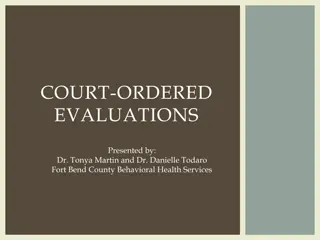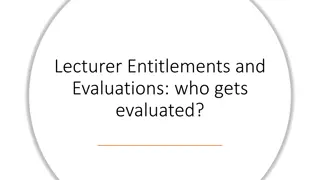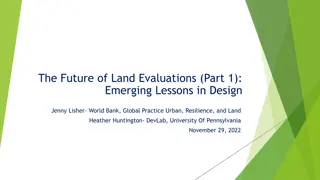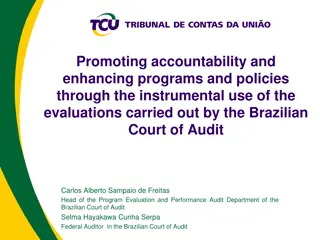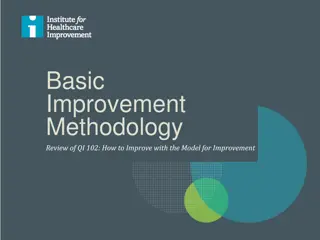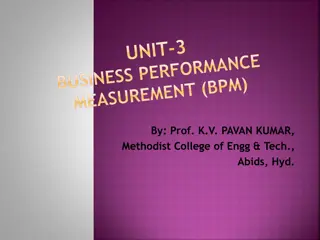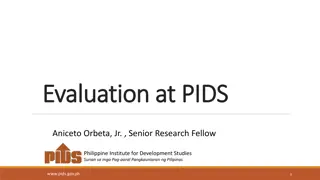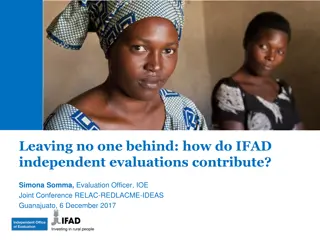Evaluations for Performance Improvement
Evaluations play a crucial role in identifying strengths and areas for improvement, whether in the workplace or on the baseball field. This article discusses the importance of evaluations, different sources of evaluations, and how self-assessment can contribute to personal growth and development.
Download Presentation

Please find below an Image/Link to download the presentation.
The content on the website is provided AS IS for your information and personal use only. It may not be sold, licensed, or shared on other websites without obtaining consent from the author.If you encounter any issues during the download, it is possible that the publisher has removed the file from their server.
You are allowed to download the files provided on this website for personal or commercial use, subject to the condition that they are used lawfully. All files are the property of their respective owners.
The content on the website is provided AS IS for your information and personal use only. It may not be sold, licensed, or shared on other websites without obtaining consent from the author.
E N D
Presentation Transcript
European Coal and Steel Community Proposed by Schuman for peace in 1950 Formally established in 1951 by Treaty of Paris France, W. Germany, Belgium, Luxembourg, The Netherlands, Italy Went on to sign Treaties of Rome ECSC EURATOM EEC
Came to be known as EC EFTA (Outer seven): Austria, Denmark, Norway, Portugal, Sweden, Switzerland and the United Kingdom UK changed policy on joining on EC Issued for accession in 1961 Non to the UK accession by French President de Gaulle (1963 and 1967) Due to fear of US influence
Accession of UK, Denmark, Ireland, Norway UK French President de Gaulle no longer in office so UK no longer has barriers for entry Colonies the question of Gibraltar Norway Question put to referendum rejected Still adopts policies Schengen, Europol etc Contributes to budget, member of EEA
Democracy returns to Greece, Spain and Portugal Greece joins in 1981 Spain and Portugal in 1986 1985 Greenland leaves the EC 1987 Turkey and Morocco apply Morocco not seen as European Turkey s accepted, only received candidate status in 2000, negotiations started in 2004
With the accession of the countries in 1981 and 1986: Population increased by 10% The area of the EU members increased by 20% The total GDP of the member states increased by 6.8% But the GDP per capita fell by 3.42%
Prior to enlargement of 1995, East+West Germany reunified in 1990 East Germany part of EC, under Germany EC becomes EU in 1993 - Maastricht Accession of Austria, Finland, Sweden Copenhagen criteria established due to candidacy of numerous post-communist countries Democracy / free market / adoption of EU Law
With the accession of the countries in 1995: Population increased by 6% The area of the EU members increased by 35% The total GDP of the member states increased by 6.5% For the first and only time in any enlargement of the EC/EU, the GDP per capita increased, by 0.20%
In 2004, 10 Eastern, mostly post communist, countries joined the EU Cyprus, Czech Republic, Estonia, Hungary, Latvia, Luthuania, Malta, Poland, Slovakia and Slovenia. Less developed states were fear of Western, more developed members Restrictions of certain members on travel/working rights of eastern people in their countries Denmark, Finland, Austria
With the accession of the countries in 2004: Population increased by 20%, largest single expansion in terms of number of people The area of the EU members increased by 18%, largest single increase in terms of km2 The total GDP of the member states increased only by 8.8% It was the largest fall of GDP per capita in any enlargement. The accession of the less developed Eastern countries caused a 9% fall in GDP per capita
The accession of Bulgaria and Romania Were supposed to join in 2004 Romania Government and judiciary reforms not completed Bulgaria More efforts needed in fight against corruption, human trafficking and reforming judicial sector
With the accession of the countries in 2007: Population increased by 6.5% The area of the EU members increased by 8.5% The total GDP of the member states increased by 2% GDP per capita fell by 4% Eastern enlargement of 2004-2007 ended the conventional view Europe ended where the Iron Curtain divided it
After Slovenia, Croatia is the second country from ex-Yugoslavia to join the EU. The European perspective remains open to the entire Western Balkans region.
Western Balkans, Turkey and Iceland Two concepts after the Eastern enlargement: absorption capacity enlargement fatigue
Candidate and potential candidate countries Wealth Area Population (million) (gross domestic product per person) (1000 km ) Bosnia and Herzegovina 51 3.8 7 300 Montenegro 13 0.6 10 500 Iceland 100 0.3 29 500 Kosovo under UN Security Resolution 1244 The former Yugoslav Republic of Macedonia 11 2.2 : 25 2.1 9 200 Albania 27 3.2 7 300 Serbia 77 7.3 8 400 Turkey 770 73.7 13 600 The 28 EU countries together 4 290 508 25 700
2009-04-01 (SAA) 2009-04-28 2014-06-24 Candidate Potential candidate Signed (SAA) 1994-01-01 Negotiations suspended 2009-07-16 2010-06-17 2010-07-27 2011-06-21 27/11 (EEA) Initialled (SAA) Potential candidate 2004-04-01 (SAA) 2004-03-22 2005-12-17 Candidate 2010-05-01 (SAA) 2008-12-15 2010-12-17 2012-06-29 2013-06-27 12/2 Negotiating 2013-09-01 (SAA) 2009-12-22 2012-03-01 2014-01-21 (Started) Negotiating 1964-12-01 1987-04-14 1999-12-12 2005-10-03 2006-10-13 14/1 Negotiating (AA)
According to the 2014 Strategy Paper: makes Europe a safer place helps improve the quality of people s lives makes EU more prosperous three pillars: rule of law economic governance public administration reform.
When a country is ready it becomes an official candidate for membership The candidate moves on to formal membership negotiations following unanimous decision by the EU Council When the negotiations and accompanying reforms have been completed to the satisfaction of both sides, the country can join the EU
The conditions and timing of the candidate's adoption, implementation and enforcement of all current EU rules (the "acquis communautaire"). 35 chapters negotiated separately financial arrangements transitional arrangements
Chapter 1: Free movement of goods Chapter 2: Freedom of movement for workers Chapter 3: Right of establishment and freedom to provide services Chapter 4: Free movement of capital Chapter 5: Public procurement Chapter 6: Company law Chapter 7: Intellectual property law Chapter 8: Competition policy Chapter 9: Financial services Chapter 10: Information society and media Chapter 11: Agriculture and rural development Chapter 12: Food safety, veterinary and phytosanitary policy Chapter 13: Fisheries
Chapter 14: Transport policy Chapter 15: Energy Chapter 16: Taxation Chapter 17: Economic and monetary policy Chapter 18: Statistics Chapter 19: Social policy and employment Chapter 20: Enterprise and industrial policy Chapter 21: Trans-European networks Chapter 22: Regional policy and coordination of structural instruments Chapter 23: Judiciary and fundamental rights Chapter 24: Justice, freedom and security Chapter 25: Science and research Chapter 26: Education and culture
Chapter 27: Environment Chapter 28: Consumer and health protection Chapter 29: Customs union Chapter 30: External relations Chapter 31: Foreign, security and defence policy Chapter 32: Financial control Chapter 33: Financial and budgetary provisions Chapter 34 - Institutions Chapter 35 - Other issues
Commission carries out a detailed examination, together with the candidate country, of each chapter. The findings by chapter are presented by the Commission to the Member States in the form of a screening report. open negotiations directly or require that certain conditions opening benchmarks - should first be met
before negotiations can start, the candidate country must submit its position and the EU must adopt a common position EU sets closing benchmarks in chapters which need to be met by the Candidate Country before negotiations in the policy field concerned can be closed. If criteria fulfilled, chapter provisionally closed
Closing the chapters No negotiations on any individual chapter are closed until every EU government is satisfied with the candidate's progress in that policy field whole negotiation process is only concluded definitively once every chapter has been closed.
the document that cements the country's membership of the EU To be binding, it has to; win the support of the EU Council, the Commission, and the European Parliament be signed by the candidate country and representatives of all existing EU countries be ratified by the candidate country and every individual EU country, according to their constitutional rules (parliamentary vote, referendum, etc.).
Security: disputes on territories, sovereignty and ethnic minorities still persist in the region Credibility of the EU as an international actor use the power of its enlargement process to transform the Western Balkans, opening a new chapter after a shameful decade of failure in the region
Stabilisation and Association Process (SAP) policy framework in 1999 Stabilisation and Association Agreements (SAA) with Croatia, Macedonia (2000), Albania (2003), Bosnia-Herzegovina, Montenegro, Serbia (2005), Kosovo (2013) Thessaloniki Summit (2003): a clear membership perspective granted to the Western Balkans, subject to fulfilment of the conditions determined by the SAP and the Copenhagen criteria
Croatia met all conditions and become a member of the EU on 1 July 2013. Macedonia, Montenegro and Serbia recognised as candidate countries, where the formal accession negotiations started with Montenegro in June 2012 and with Serbia in January 2014. Albania applied for EU membership in 2009, and in October 2012 the European Commission recommended that Council should grant Albania candidate status. Granted candidate status in June 2014 Bosnia-Herzegovina and Kosovo has not applied for membership yet, but the EU recognises these countries as potential candidates.
PHARE, ECHO (1990) Obnova (1996) CARDS (2000) IPA (2007) IPA II (2014)
, Poland and Hungary Assistance for Restructuring their Economies (PHARE) programme (1990) initially targeting assistance to Poland and Hungary, expanded to the pre-accession assistance of the 2004 and 2007 entrant countries and three countries from the Western Balkans, Albania, Macedonia, and Bosnia-Herzegovina
European Consensus on Humanitarian Aid (ECHO) (1990) included support to refugees, internally displaced persons and vulnerable groups and aimed at restoring livelihood conditions and fostering post-war infrastructure reconstruction. Obnova (reconstruction) (1996) In the 1990s, around 4.4 billion was allocated to the projects aiming at the physical, social and political reconstruction of the Western Balkans.
PHARE, ECHO and Obnova were limited to post-conflict reconstruction of the region. Community Assistance for Reconstruction, Development and Stabilisation (CARDS) programme building up an institutional, legislative, economic and social framework directed at the values and models subscribed to by the EU
Financial assistance (4.6 billion in total) concentrated at a wide range of issues integrated border management, public administration reform, taxation, local infrastructure development, civil society development, media reform, strengthened environment policies and economic reforms.
2002 2003 2004 2005 2006 Albania 44.9 46.5 63.5 44.2 45.5 Bosnia-Herzegovina 71.9 63 72 49.4 51 Croatia 59 62 81 105 140 Macedonia 41.5 43.5 59 45 40 Serbia 189.7 240 218 154.5 179 Montenegro 15 15 19 22 24.5 Kosovo 154.9 76.28 75.4 54 89.5 Source: European Commission, DG Enlargement. Financial statistics per country 2000-2006
Instrument for Pre-Accession Assistance (IPA) programme Replaced all previous instruments for both official candidate (Croatia, Macedonia, Montenegro, Turkey, and Iceland) and potential candidate countries (Albania, Bosnia-Herzegovina, Serbia and Kosovo) Aims at providing assistance to these countries in harmonization and implementation of the EU acquis and preparation for use of the cohesion and structural funds after EU accession.
Component I: Assistance for transition and institution-building Component II: Cross-border cooperation Component III: Regional development Component IV: Human resources development Component V: Rural development
allocation of the IPA funds for each component and beneficiary country was defined in the Multiannual Indicative Financial Framework (MIFF), which reflects the priorities identified by the Enlargement Strategy of the European Commission First MIFF: 2008-2010 Second MIFF: 2011-2013
Country Component Transition Assistance and Institution Building Cross-border Cooperation Regional Development Human Resources Development Rural Development Total 2007 2008 2009 2010 256.7 2.1 167.5 50.2 20.7 497.2 256.1 2.8 173.8 52.9 239.6 3.1 182.7 55.6 85.5 566.4 231.3 5.1 238.1 63.4 131.3 653.7 TURKEY 53 538.7 Transition Assistance and Institution Building Cross-border Cooperation Regional Development Human Resources Development Rural Development Total 49.6 9.7 45.1 11.4 25.5 141.2 45.4 14.7 47.6 12.7 25.6 146 45.6 15.9 49.7 14.2 25.8 151.2 39.5 15.6 56.2 15.7 26 153.6 CROATIA Transition Assistance and Institution Building Cross-border Cooperation Regional Development Human Resources Development Rural Development Total 41.6 4.2 7.4 3.2 2.1 58.5 41.1 4.1 12.3 39.3 4.3 20.8 7.1 10.2 81.8 36.9 4.5 29.4 8.4 12.5 91.7 MACEDONIA 6 6.7 70.2
Transition Assistance and Institution Building Cross-border Cooperation Total 181.5 8.2 189.7 179.4 11.5 190.9 182.6 12.2 194.8 186.2 11.8 198 SERBIA Transition Assistance and Institution Building Cross-border Cooperation Total 27.5 3.9 31.4 28.1 4.5 32.6 29.8 4.7 34.5 29.8 3.7 33.5 MONTENEGRO Transition Assistance and Institution Building Cross-border Cooperation Total 68.3 184.7 106.1 66.1 1.2 67.3 KOSOVO 0 0 0 68.3 184.7 106.1 Transition Assistance and Institution Building Cross-border Cooperation Total 58.1 69.9 4.9 74.8 83.9 5.2 89.1 100.7 4.7 105.4 BOSNIA-HERZEGOVINA 4 62.1 Transition Assistance and Institution Building Cross-border Cooperation Total 54.3 6.7 61 65.2 8.6 73.8 71.4 9.8 81.2 84.2 10 94.2 ALBANIA Total Country Programmes Multi-Beneficiary Programmes Support Expenditure GRAND TOTAL 1109.4 29.6 44.8 1263.2 1311.7 137.7 1305.1 188.9 47.6 1541.6 1397.3 141.7 47.4 1591.3 52 1501.4
Country Component 2011 2012 2013 Transition Assistance and Institution Building Cross-border Cooperation Regional Development Human Resources Development Rural Development Total 29.8 4.3 16.3 4.6 5.1 4.7 14.8 2.8 7.3 34.6 Transition Assistance and Institution Building Cross-border Cooperation Regional Development 231.3 227.5 238.5 5.1 2.2 293.4 356.1 366.9 2.2 0 0 0 8 2.8 3.3 35 Human Resources Development Rural Development Total 77.6 172.5 187.4 204.2 779.9 856.3 902.9 83.2 91.2 MONTENEGRO 34.2 TURKEY Transition Assistance and Institution Building Cross-border Cooperation Total 66.9 1.8 68.7 67 1.8 68.8 68.5 Transition Assistance and Institution Building Cross-border Cooperation Regional Development 3 40 40 17.4 9.7 30.1 KOSOVO 71.5 15.9 58.2 16.4 57.5 Transition Assistance and Institution Building Cross-border Cooperation Total 102.7 4.7 107.4 102.7 103.5 5.2 107.9 108.8 Human Resources Development Rural Development Total 16 15.9 25.8 8.5 27.7 93.5 5.3 BOSNIA- HERZEGOVINA 26.5 156.5 155.6 CROATIA Transition Assistance and Institution Building Cross-border Cooperation Total Transition Assistance and Institution Building Cross-border Cooperation Regional Development 84.3 10.1 94.4 85.1 9.4 94.6 84.7 10.7 95.3 29.4 4.5 39.3 28.7 3.6 40.9 27.1 5.1 50.3 ALBANIA Human Resources Development Rural Development Total 8.8 16 98 101.5 113.2 10.3 18 10.6 20.2 Total Country Programmes Multi-Beneficiary Programmes Support Expenditure 1553 193.2 52.2 1633.7 1634.1 212.7 177.3 52.7 MACEDONIA 53.3 Transition Assistance and Institution Building Cross-border Cooperation Total 190.6 190.6 196.7 11.3 11.5 201.9 202.1 208.3 GRAND TOTAL 1798.4 1899.1 1864.6 11.6 SERBIA





